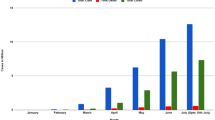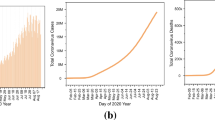Abstract
The coronavirus disease (COVID-19) has been identified and widely known as an invisible enemy in the history of mankind. The novel coronavirus continued to pose a significant risk to health, and even death of human on earth. Originated December 2019, in the Wuhan province of China, now vastly spreading around the globe like wildfire. The coronavirus pandemic caused the largest global largest recession in the history of mankind, with the largest global population at the time being placed on lockdown, quarantine, and isolation due to vastly spread of the pandemic. The initial stages of this outbreak, all over the countries around the globe, including the USA, faced one major threat—a lack of diagnostic tools and proper testing. In this context, the first step in medical practice is Diagnosis, which is very crucial for clinical decision making. Researchers have used different computational intelligence techniques to classify different types of diseases, such as Diabetes, Cancer, Epilepsy, Lungs, heart disease and Liver, etc., therefore, COVID-19 should not be an exception. This Chapter will systematically talk about the recent state-of-the-art computational intelligence (CI) approaches in the field of medical diagnosis of COVID-19 based on the medical image.
Access this chapter
Tax calculation will be finalised at checkout
Purchases are for personal use only
Similar content being viewed by others
References
McFall, J., Uliana, K., & Lauren Frias, M. (2020, March 14). A third of the global population is on coronavirus lockdown—Here’s our constantly updated list of countries and restrictions, Business Insider Australia.
Greenspan, H., Van, G. B., & Summers, R. M. (2016). Guest editorial deep learning in medical imaging: Overview and future promise of an exciting new technique. IEEE Transactions on Medical Imaging, 35(5), 1153–1159.
Deng, J., Dong, W., Socher, R., Li, L. J., Li, K., Fei, F. (2009). Imagenet: A large-scale hierarchical image database. In 2009 IEEE Conference on Computer Vision and Pattern Recognition.
Weinstein, E. A., et al. (2013). The cancer genome atlas pan-cancer analysis project. Nature Genetics, 45(10), 11–13.
Jensen, P. B., Jensen, L. J., & Brunak, S. (2012). Mining electronic health records: Towards better research applications and clinical care. Nature Reviews Genetics, 13(6), 395.
National Academies of Sciences and Medicine (2016). Improving diagnosis in health care, National Academies Press.
Cios, K. J., & Moore, G. W. (2002). Uniqueness of medical data mining. Artificial Intelligence in Medicine, 26(1), 1–24.
Jain, A. K., Mao, J., & Mohiuddin, K. (1996). Artificial neural networks: A tutorial. Computer, 3, 31–44.
World Health Organization. (2018). “Infectious Disease,” WHO.
Chen, J. H., & Asch, S. M. (2017). Machine learning and prediction in medicine—Beyond the peak of. New England Journal of Medicine, 376(26), 2507–2509.
Boon, I. S., Yong, T. T., & Boon, C. S. (2018). Assessing the role of artificial intelligence (AI) in clinical oncology: Utility of machine learning in radiotherapy target volume delineation. Medicines (Basel), 5(4).
Im, H., Pathania, D., McFarland, P. J., Sohani, A. R., Degani, I., Allen, M., et al. (2018). Design and clinical validation of a point-of-care device for the diagnosis of lymphoma via contrast-enhanced microholography and machine learning. Nature Biomedical Engineering, 2(9), 666–674.
Martini, M., Gazzaniga, V., Bragazzi, N. L., & Barberis, I. (2019). The Spanish influenza pandemic: A lesson from history 100 years after 1918. Journal of Preventive Medicine and Hygiene, 60, E64–E67.
Duncan, C. J., & Scott, S. (2005). What caused the black death? [CrossRef] [PubMed]. Postgraduate Medical Journal, 81, 315.
CDC. Influenza (flu). Retrieved on April 25, 2020, from https://www.cdc.gov/flu/pandemic-resources/2009-h1n1-pandemic.html.
Song, Z., Xu, Y., Bao, L., Zhang, L., Yu, P., Qu, Y., Zhu, H., Zhao, W., Han, Y., & Qin, C. (2019). From sars to mers, thrusting coronaviruses into the spotlight. Viruses, 11, 59.
Sun, G., Matsui, T., Hakozaki, Y., & Abe, S. (2015). An infectious disease/fever screening radar system which stratifies higher-risk patients within ten seconds using a neural network and the fuzzy grouping method. Journal of Infection, 70(3), 230–236.
Fraley, S. I., Athamanolap, P., Masek, B. J., Hardick, J., Carroll, K. C., Hsieh, Y. H., et al. (2016). Nested machine learning facilitates increased sequence content for large-scale automated high resolution melt genotyping. Scientific Reports, 6.
Saybani, M. R., Shamshirband, S., Hormozi, S. G., Wah, T. Y., Aghabozorgi, S., Pourhoseingholi, M. A., & Olariu, T. (2015). Diagnosing tuberculosis with a novel support vector machine-based artificial immune recognition system. Iranian Red Crescent Medical Journal, 17(4), e24557.
Watkins, A., & Boggess, L. C. (2002). A new classifier based on resource limited artificial immune systems. In Proceedings of Congress on Evolutionary Computation IEEE World Congress on Computational Intelligence, Honolulu.
Cuevas, E., Osuna-Enciso, V., Zaldivar, D., Perez-Cisneros, M., & Sossa, H. (2012). Multi-threshold segmentation based on artificial immune systems. Mathematical Problems in Engineering, 20.
Go, T., Kim, J. H., Byeon, H., & Lee, S. J. (2018). Machine learning-based in-line holographic sensing of unstained malaria-infected red blood cells. Journal of Biophotonics, 11(9), e201800101.
Corman, V. M., Landt, O., Kaiser, M., Molenkamp, R., Meijer, A., Chu, D. K., et al. (2020). Detection of 2019 novel coronavirus (2019-nCoV) by real-time RT-PCR. Eurosurveillance, 25.
Gozes, O., Frid-Adar, M., Greenspan, H., Brownin, D. P., Zhang, H., Ji, W., Bernheim, A., & Siegel, E. (2020). Rapid AI development cycle for the coronavirus (covid-19) pandemic: Initial results for automated detection & patient monitoring using deep learning ct image analysis. arXiv:2003.05037.
Rajpurkar, P., Irvin J., Zhu, K., Yang, B., Mehta, H., Duan, et al. (2017). Radiologist-level pneumonia detection on chest x-rays with deep learning. arXiv:1711.05225.
Charmaine, B., Jagpal, G., David, C., & Benson, A. B. (2020). Deep learning system to screen coronavirus disease 2019 pneumonia. Applied Intelligence.
Zheng, C., Deng, X., Fu, Q., Zhou, Q., Feng, J., Ma, H., Liu, W., & Wang, X. (2020). Deep learning-based detection for covid-19 from chest ct using weak label, medRxiv.
Chowdhury, M. E., Rahman, T., Khandakar, A., Mazha, R., Kadir, M. A., Mahbub, Z. B., et al. (2020). Can AI help in screening viral and covid-19 pneumonia? arXiv:2003.13145.
Li, L., Qin, L., Xu, Z., Yin, Y., Wang, X., Kong, B., et al. (2020). Artificial intelligence distinguishes covid-19 from community acquired pneumonia on chest ct. Radiology, 200905.
Song, Y., Zheng, S., Li, L., Zhang, X., Zhang, X., Huang, Z., et al. (2020). Deep learning enables accurate diagnosis of novel coronavirus (covid-19) with ct images, medRxiv.
Wang, S., Kang, B., Ma, J., Zeng, X., Xiao, M., Guo, J., et al. (2020). A deep learning algorithm using ct images to screen for corona virus disease (covid-19), medRxiv.
Shan, F., Gao, Y., Wang, J., Shi, W., Shi, N., Han, M., et al. (2020). Infection quantification of covid-19 in ct images with deep learning. arXiv:2003.04655.
Chen, I., Wu, L., Zhang, J., Zhang, L., Gong, D., Zhao, Y., et al. (2020). Deep learning-based model for detecting 2019 novel coronavirus pneumonia on high-resolution computed tomography: A prospective study, medRxiv.
Shi, F., Xia, L., Shan, F., Wu, D., Wei, Y., Yuan, H., et al. (2020). Large-scale screening of covid-19 from community acquired pneumonia using infection size-aware classification. arXiv:2003.09860.
Bernheim, A., Mei, X., Huang, M., Yang, Y., Faya, Z. A., Zhang, N., et al. (2020). Chest ct findings in coronavirus disease-19 (covid-19): relationship to duration of infection. Radiology, 200463.
Gozes, O., Frid-Adar, M., Greenspan, H., Browni, P. D., Zhang, H., Ji, W., et al. (2020). Rapid AI development cycle for the coronavirus (covid-19) pandemic: Initial results for automated detection & patient monitoring using deep learning ct image analysis. arXiv:2003.05037.
Bertolini, D., Teixeira, L. O., Silla, C. N. Jr., & Costa, Y. G. (2020). COVID-19 identification in chest X-ray images on flat and hierarchical classification scenarios. arXiv:2004.05835.
Apostolopoulos, I. D., & Mpesiana, T. A. (2020). Covid-19: Automatic detection from x-ray images utilizing transfer learning with convolutional neural networks. Physical and Engineering Sciences in Medicine.
Ai, T., Yang, Z., Hou, H., Zhan, C., Chen, C., Lv, W., et al. (2020). Correlation of chest CT and RT-PCR testing in coronavirus disease 2019 (COVID-19) in China: A report of 1014 cases. Radiology, 200642.
Cohen, J. P., Hashir, M., Brooks, R., & Bertrand, H. (2020). On the limits of cross-domain generalization in automated X-ray prediction. arXiv:2002.02497.
Makoul, G., Curry, R. H., & Tang, P. C. (2001). The use of electronic medical records: Communication patterns in outpatient encounters. [CrossRef] [PubMed]. Journal of the American Medical Informatics Association, 8, 610–615.
Westin, A., Krane, D., Capps, K., & Peterson, T. (2012). Making it meaningful: How consumers value and trust health it survey; national partnership for women & families, Washington, DC, USA.
Xuehai, H., Xingyi, Y., Shanghang, Z., Jinyu, Z., Yichen, Z., & Eric, X. (2020). Sample-efficient deep learning for COVID-19, medRxiv.
Lannquist, Y. (2018). Ethical & policy risks of artificial intelligence in healthcare. Retrieved on May 18, 2020, from https://www.thefuturesociety.org/ethical-policy-risks-of-artificialintelligence-in-healthcare/.
Lufkin, B. (2017). Why the biggest challenge facing AI is a ethical one. Retrieved May 22, 2020, from https://www.bbc.com/future/story/20170307-the-ethical-challenge-facingartificial-intelligence?obOrigUrl=true.
Raza, K., & Singh, N. K. (2018). A tour of unsupervised deep learning for medical image analysis. arXiv:1812.07715.
Disruptive dozen. Cambridge (MA): World Medical Innovation Forum (2018). Retrieved on May 25, 2020, from https://worldmedicalinnovation.org/wp-content/uploads/2018/04/Partners-FORUM-2018-BROCHURE-D12-AI-180410_1202-FREV2-FORWEB-X3.pdf.
Suzuki, K. (2017). Overview of deep learning in medical imaging. Radiological Physics and Technology, 10(3), 257–273.
Gillies, R. J., Kinahan, P. E., & Hricak, H. (2016). Radiomics: Images are more than pictures, they are data. Radiology, 278(2), 563–577.
Hatt, M., Tixier, F., Visvikis, D., & Cheze Le Rest, C. (2017). Radiomics in PET/CT: More than meets the eye? Journal of Nuclear Medicine, 58(3), 365–366.
Krittanawong, C., Tunhasiriwet, A., Zhang, H., Wang, Z. A., Aydar, M., & Kitai, T. (2017). Deeplearning with unsupervised feature in echocardiographic imaging. Journal of American College of Cardiology, 69(16), 2100–2101.
Brady, A. P. (2017). Error and discrepancy in radiology: Inevitable or avoidable? Insights Imaging, 8, 171–182.
Paredes, M. (2018). Can artificial intelligence help reduce human medical error? Two examples from ICUs in the US and Peru.
Loria, K. (2018) Putting the AI in radiology. Radiology Today, 19(1).
Davenport, T. H., & Dreyer, K. J. (2018). AI will change radiology, but it won’t replace radiologists. Harvard Business Review.
Tang, A., Tam, R., Cadrin-Chênevert, A., Guest, W., Chong, J., & Barfett, J. (2018). Canadian association of radiologists white paper on artificial intelligence in radiology. Canadian Association of Radiologists Journal, 69(2), 120–135.
Medical imaging in the age of artificial intelligence. Erlangen (DE), Siemens (2017). Retrieved on May 19, 2020, from https://www.siemens.com/press/pool/de/events/2017/healthineers/2017-11-rsna/white-paper-medical-imaging-in-the-age-ofartificial-intelligence.pdf.
FDA permits marketing of clinical decision support software for alerting providers of a potential stroke in patients, U.S. Food & Drug Administration (2018). Retrieved on May 24, 2018, from https://www.fda.gov/NewsEvents/Newsroom/PressAnnouncements/ucm596575.htm.
Harvey, H. (2017). Nightmare on ML street: the dark potential of AI in radiology. Retrieved on May 15, 2020, from https://towardsdatascience.com/nightmare-on-ml-street-the-darkpotential-of-ai-in-radiology-71074e70da91.
Paiva, O. A., & Prevedello, L. M. (2017). The potential impact of artificial intelligence in radiology. Radiologia brasileira, 50(5).
Harrington, S. G., & Johnson, M. K. (2018). The FDA and artificial intelligence in radiology: Defining new boundaries. Journal of American College of Radiology, 18, 31343–31347.
Acknowledgements
Thanks to all experts who have contributed in one way or the other towards completion of this work. The content is solely the responsibility of the author and does not necessarily reflect the views of anybody.
Author information
Authors and Affiliations
Corresponding author
Editor information
Editors and Affiliations
Rights and permissions
Copyright information
© 2021 The Editor(s) (if applicable) and The Author(s), under exclusive license to Springer Nature Singapore Pte Ltd.
About this chapter
Cite this chapter
Isa, A. (2021). Computational Intelligence Methods in Medical Image-Based Diagnosis of COVID-19 Infections. In: Raza, K. (eds) Computational Intelligence Methods in COVID-19: Surveillance, Prevention, Prediction and Diagnosis. Studies in Computational Intelligence, vol 923. Springer, Singapore. https://doi.org/10.1007/978-981-15-8534-0_13
Download citation
DOI: https://doi.org/10.1007/978-981-15-8534-0_13
Published:
Publisher Name: Springer, Singapore
Print ISBN: 978-981-15-8533-3
Online ISBN: 978-981-15-8534-0
eBook Packages: Intelligent Technologies and RoboticsIntelligent Technologies and Robotics (R0)




